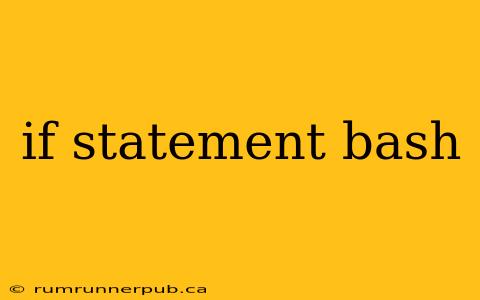Bash scripting is a powerful tool for automating tasks on Linux and other Unix-like systems. A core component of any bash script is the conditional statement, most commonly implemented using the if statement. This article will explore various ways to use if statements in Bash, drawing upon insights from Stack Overflow and adding practical examples and explanations to enhance your understanding.
Basic if Statement Structure
The fundamental structure of a Bash if statement is straightforward:
if [ condition ]; then
# Commands to execute if the condition is true
fi
The [ ] (or its equivalent test) evaluates a condition. If the condition is true (returns an exit status of 0), the commands within the then and fi blocks are executed. fi marks the end of the if statement.
Example (from Stack Overflow user, adapted):
Let's say we want to check if a file exists:
file="/path/to/my/file.txt"
if [ -f "$file" ]; then
echo "File '$file' exists."
fi
This uses the -f operator to test if the specified path is a regular file. Crucially, we quote the variable $file to prevent word splitting and globbing issues. This is a best practice you should always follow when working with variables in Bash.
Analysis: The -f operator is just one of many file test operators available in Bash. Others include -d (directory), -e (exists), -r (readable), -w (writable), and -x (executable). Consult the man test page for a complete list.
if-else Statements: Handling Multiple Possibilities
Often, you'll need to handle cases where a condition might be false. This is where the else clause comes in:
if [ condition ]; then
# Commands if condition is true
else
# Commands if condition is false
fi
Example: Let's expand the file existence check:
file="/path/to/my/file.txt"
if [ -f "$file" ]; then
echo "File '$file' exists."
else
echo "File '$file' does not exist."
fi
This provides a more comprehensive response to the user.
if-elif-else Statements: Nested Conditions
For more complex scenarios with multiple conditions, you can use elif (else if):
if [ condition1 ]; then
# Commands if condition1 is true
elif [ condition2 ]; then
# Commands if condition2 is true
else
# Commands if neither condition1 nor condition2 is true
fi
Example (inspired by Stack Overflow discussions on comparing numbers):
Let's check if a variable holds a positive, negative, or zero value:
num=10
if (( num > 0 )); then
echo "The number is positive."
elif (( num < 0 )); then
echo "The number is negative."
else
echo "The number is zero."
fi
Here, (( )) is used for arithmetic comparison. This is generally preferred over [ ] for numerical operations.
String Comparisons
Comparing strings in Bash requires specific operators:
=: equal to!=: not equal to<: lexicographically less than>: lexicographically greater than
Example:
name="John Doe"
if [ "$name" = "John Doe" ]; then
echo "Name matches!"
fi
Important Note: Always quote your variables in string comparisons to avoid unexpected behavior.
Conclusion
Mastering Bash if statements is crucial for writing effective scripts. By understanding the basic structure, incorporating else and elif clauses, and correctly using comparison operators, you can create powerful and flexible scripts to automate a wide range of tasks. Remember to consult the man test and man bash pages for comprehensive information and always prioritize safe coding practices like quoting your variables. This article, drawing on common Stack Overflow questions and adding practical context, provides a solid foundation for building your Bash scripting skills.
